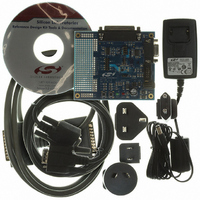TEMPCOMPRTC-RD Silicon Laboratories Inc, TEMPCOMPRTC-RD Datasheet - Page 3

TEMPCOMPRTC-RD
Manufacturer Part Number
TEMPCOMPRTC-RD
Description
KIT REF DES TEMP COMPENS RTC
Manufacturer
Silicon Laboratories Inc
Datasheet
1.TEMPCOMPRTC-RD.pdf
(14 pages)
Specifications of TEMPCOMPRTC-RD
Main Purpose
Timing, Real Time Clock (RTC)
Embedded
Yes, MCU, 8-Bit
Utilized Ic / Part
C8051F300
Primary Attributes
I²C, RS-232, SMBus Interfaces
Secondary Attributes
A Keil Compiler and USB Debug Adapter are required
Processor To Be Evaluated
C8051F300
Interface Type
RS-232
Lead Free Status / RoHS Status
Contains lead / RoHS non-compliant
Lead Free Status / RoHS Status
Lead free / RoHS Compliant, Contains lead / RoHS non-compliant
Other names
336-1351
4. TC-RTC Evaluation Board
The functions of the major components on the TC-RTC Evaluation Board that are labeled in Figure 1 are listed
below. The board schematic and bill of materials are shown in Sections 7 and 8, respectively.
In addition to these, a RS-232 transceiver and a buffer are used for the serial and SMBus interfaces, respectively.
5. TC-RTC Firmware
The clock accuracy of a time-keeping system based on a resonating quartz crystal is primarily affected by the
variation of crystal frequency with respect to temperature. Figure 2 shows a plot of the variation of crystal
frequency versus temperature. From the parabolic curve, it can be seen that the RTC will lose time if the
temperature is increased or decreased from the room temperature value (25 °C). The RTC will never have a
positive error caused by temperature variations (i.e., gain time) because the maximum frequency is at room
temperature.
The TC-RTC firmware running on the C8051F300 MCU eliminates this time loss because of temperature
variations. It uses the on-chip ADC and temperature sensor to measure the temperature every minute and
compensate for the lost time at the end of the day by adding the accumulated error to the RTC’s reported time.
This is explained in more detail in “AN293: Temperature Compensated Real Time Clock Reference Design
Programmer’s Guide”.
The time maintained by the TC-RTC can be accessed via two interfaces—a RS-232 serial interface via a DB9
connector and an SMBus interface via a DB25 connector. The preloaded firmware is built to work with the RS-232
serial interface. Also included in the AN293SW.zip package is a pre-built OMF file, which enables the SMBus
interface to the RTC when loaded into the device. The AN293SW.zip package contains the full source code as
well.
C8051F300 MCU (U3)—Microcontroller with firmware to perform the TC-RTC function.
32.768 kHz Crystal (Y1)—This low-cost watch crystal is used for time keeping.
DB9 connector (J5)—This is for the serial RS-232 connection.
DB25 connector (J6)—This is for the optional parallel connection with SMBus interface.
Figure 2. Crystal Frequency Variation Due to Temperature
Rev. 0.1
TEMPCOMPRTC-RD
3










